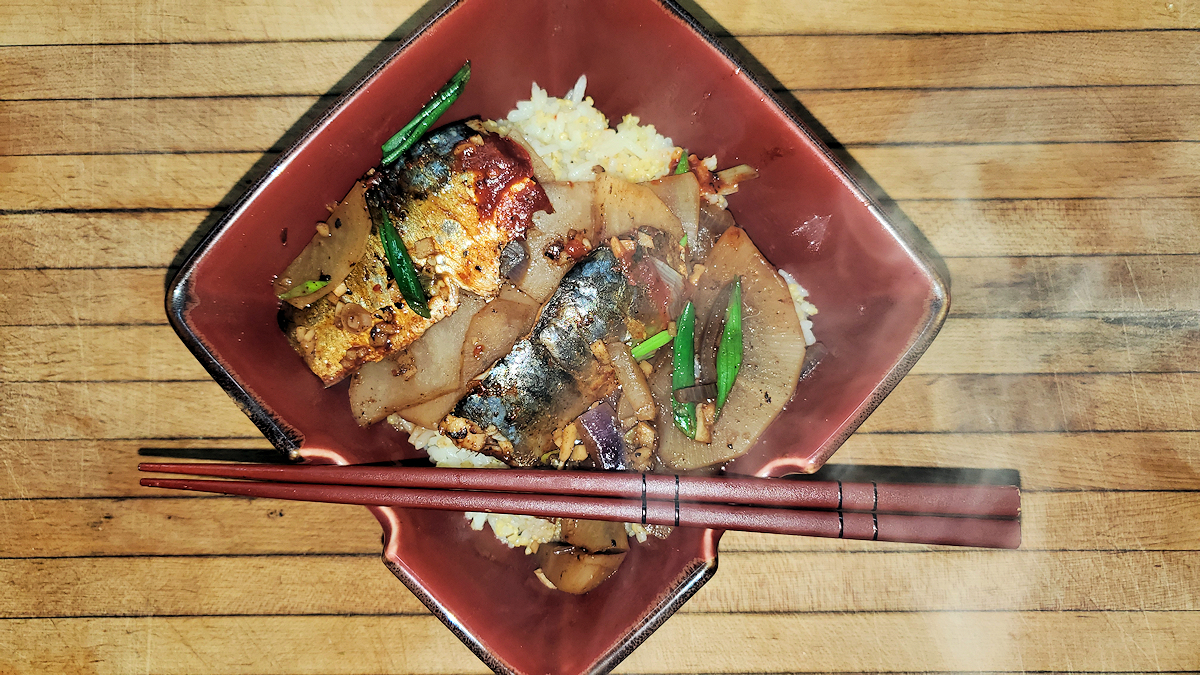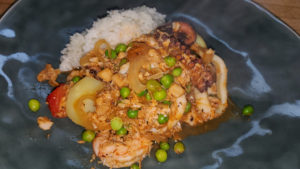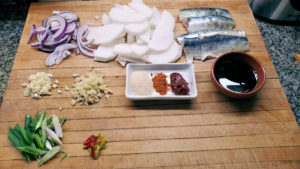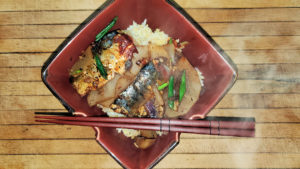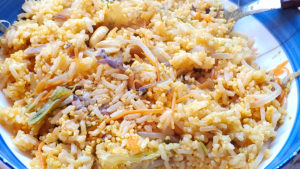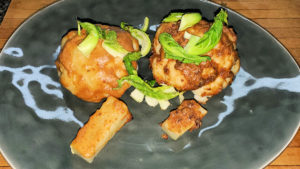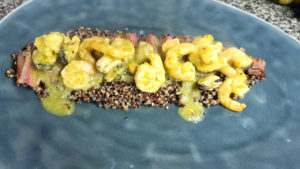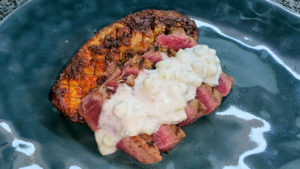July was less of a soup month than June – not sure why. Or maybe it’s just that we didn’t make any particular interesting or unusual soups like we did the previous month. But here, a round up of fun things we did eat at home – or, mostly me, because Henry spent half the month in Peru – some of which are destined, with more refinement, for Casa SaltShaker dinners down the line.
My take on a seafood “antichuera” – basically mixed seafood and vegetables with the sauce used to make anticuchos, the traditional grilled meats on skewers of Peruvian tradition. It’s a mix of seafood – shrimp, scallops, calalmari rings, some parcooked small octopus tentacles, and some diced fish – merluza, or hake that have been quickly stewed in a paste of onions, garlic, rocoto and panca chilies, a little dark beer, oregano, and vinegar, and then tossed with par cooked potatoes, cherry tomatoes, and peas. Served with traditional Peruvian garlic rice.
I had picked up a couple of fresh sardines at the fish market and was in the mood for Korean food. Easy enough to find several versions of a recipe for kkongchi-jorim, a quick cooked spicy braise of either sardines or mackerel. The prep took minimal time, filleting the fish and picking out the bones took the longest, then slicing up an onion (normally made with white onion, but the only one I had in house at the moment was rotten inside, so I just made this with a red onion), quartering and slicing some daikon, and then finely chopping garlic and ginger, slicing some green onions and chilies. The braise is quick and easy – in a pot just big enough to make a single layer of the fish fillets, I put the onions in the bottom with a splash of oil, over medium heat, then topped them with a layer of the daikon, and then the fish fillets, skin side up. Made a paste of the middle row there – garlic, ginger, sugar, chili flakes, chili paste, and soy sauce, and poured that all over the fish. A splash of water in the bottom, covered the pot, and cooked for about 10-12 minutes – twice just using a spoon to scoop out the liquid forming in the bottom and splash it over the top, ensuring a good mixing of all the ingredients. It’s served over millet rice…
…a new passion of mine, and also a popular Korean way to make rice – this version is with vegetables, the one with the fish dish above was plain. I put a cup of rice and a half cup of millet in a pot, with 1 tablespoon of chili paste (gochujang), 1 tablespoon of sesame oil, a pinch of salt, and 3 cups of water. Bring to a boil, covered, and then reduce heat to minimum and cook for 20 minutes. For the vegetable version I add slivered vegetables (beansprouts, cabbage, carrots, green onions in this case) during the last five minutes of cooking. Done. More than once this has been a quick, easy, and simple dinner for me.
More of an experiment than anything else, but made for a casual, light dinner for me one night. I love roasted cauliflower, and one of my favorite ways is rubbed with miso. This was just playing around to see the difference in extremes – the one on the left is rubbed with a mix of white miso, a little sesame oil, soy sauce, and chili flakes, the one on the right, the same except using Korean doenjang, a much more pungent and chunky fermentation of soybeans. Just for prettiness it’s garnished with some quickly sautéed cauliflower leaves, and in front are the peeled stems of the two cauliflowers – I don’t like to waste them, they’re as delicious as the cauliflower itself after you remove the thick peel. Results? Very different. The miso version is almost sweet, like barbecued, and a very familiar flavor, as it’s something many of us have had many times. The doenjang version is funky, spicy, and very “in your face”. I liked them both.
This one is, at the outset, a mashup of some leftovers with a piece of steak. But it’s the beginnings of an idea for down the road of a sort of Andean/Amazonian influenced surf and turf. The steak part is simple, a piece of entraña, or hanger steak, lightly crusted with salt and pepper and grilled to medium rare, then rested and sliced. It’s served over a bed of quinua – the quinua I’d made to crust fillets of cod in that weekend’s menu. It’s a mix of white, red, and black quinua, seasoned with salt, pepper, and celery seed. The sauce comes from the same menu, our soup of the week, timbuche. It’s an Amazonian soup that I’ve talked about a bit in the past, and it’s quite simple. But in essence, what we have here is a mix of shrimp and mussels with a puree of onions, garlic, yuca, chili, cilantro, and parsley with enough shellfish stock to puree them. I can already see the things to be done with it – I’d probably take out the yuca, and maybe use beef stock, and just barely enough of it to create that puree. I think I’d also leave the celery seed out of the quinua, it doesn’t pair as well with the beef as it did with fish.
Multi-cultural mashup… tuna tataki (Japanese), seared tuna, spice rubbed, though the spices instead of the usual shichimi mix were a Andeian mix of salt, pepper, cumin, and merquén (smoked chili). The sauce is basically an Indian raita – cucumber, yogurt, salt, pepper, cumin. The eggplant is scored in a diamond pattern and then rubbed with a chojang (Korean) mixture of gochujang chili paste, honey, sesame oil, soy sauce, and doenjang (fermented soybean paste), wrapped in foil and roasted in the oven for 45 minutes. Yum. Other than the fact that tuna is difficult to get here, and only comes frozen in blocks, and really expensive, this dish would show up on a menu as is. I’ll have to play around for a substitute….
And, that’s the interesting stuff from July’s home dinner experiments. Look for some of them to reappear in some sort of form in future Casa S dinners….
